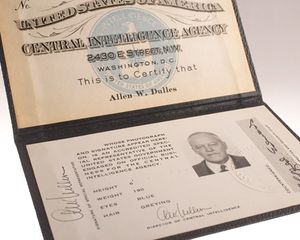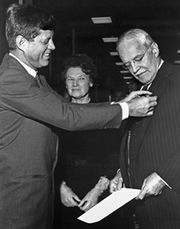ألن دلس
ألن دلس Allen Dulles | |
|---|---|
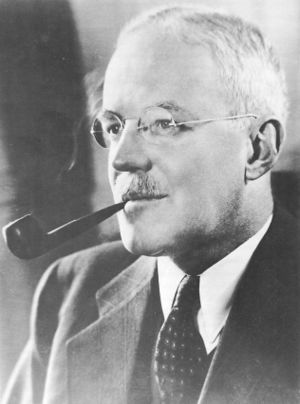 | |
| مدير وكالة المخابرات المركزية | |
| في المنصب 26 فبراير 1953 – 29 نوفمبر 1961 | |
| الرئيس | دوايت أيزنهاور جون كندي |
| النائب | تشارلز پ. كابل |
| سبقه | والتر ب. سميث |
| خلـَفه | جون مكون |
| نائب مدير وكالة المخابرات المركزية | |
| في المنصب 23 أغسطس 1951 – 26 فبراير 1953 | |
| الرئيس | هاري ترومان دوايت أيزنهاور |
| سبقه | وليام هـ. جاكسون |
| خلـَفه | تشارلز كابل |
| نائب مدير وكالة المخابرات المركزية للخطط | |
| في المنصب 4 يناير 1951 – 23 أغسطس 1951 | |
| الرئيس | هاري ترومان |
| سبقه | تأسيس المنصب |
| خلـَفه | فرانك وايزنر |
| تفاصيل شخصية | |
| وُلِد | Allen Welsh Dulles أبريل 7, 1893 واترتاون، نيويورك، الولايات المتحدة |
| توفي | يناير 29, 1969 (aged 75) واشنطن العاصمة، الولايات المتحدة |
| المثوى | مقبرة گرين ماونت |
| الحزب | جمهوري |
| الزوج | مارثا "كلوڤر" تود (ز. 1920) |
| الأنجال | 3 |
| الأقارب | John Foster Dulles (brother) John Welsh Dulles (grandfather) Miron Winslow (great-grandfather) Harriet Winslow (great-grandmother) Avery Cardinal Dulles (nephew) Dulles family |
| التعليم | جامعة پرنستون (ب.ف.) جامعة جورج واشنطن (ب.ح.) |
ألن ولش دلس ( /ˈdʌləs/؛ و. 7 أبريل 1893 - ت. 29 يناير 1969)، هو دبلوماسي ومحامي أمريكي، وكان أول مدير مدني لوكالة المخابرات المركزية، وأطول مديريها خدمة حتى الآن. كرئيس للمخابرات المركزية في أوائل الحرب الباردة، شهد الانقلاب الإيراني 1953، الانقلاب الگواتيمالي 1954، برنامج الطائرة لوكهيد يو-2، Project MKUltra للتحكم في العقول وغزو خليج الخنازير. أقاله جون كندي بسبب فشله الذريع.
كان دلس أحد أعضاء لجنة وارن التي حققت في اغتيال جون كندي. ما بين فترات عمله الحكومي، كان دلس محامي شركات وشريك في سوليڤان أند كروموِل. شقيقه الأكبر، جون فوستر دلس، كان وزيراً للخارجية في إدارة أيزنهاور وعلى اسمه سُمي مطار دلس الدولي.[1]
. . . . . . . . . . . . . . . . . . . . . . . . . . . . . . . . . . . . . . . . . . . . . . . . . . . . . . . . . . . . . . . . . . . . . . . . . . . . . . . . . . . . . . . . . . . . . . . . . . . . . . . . . . . . . . . . . . . . . . . . . . . . . . . . . . . . . . . . . . . . . . . . . . . . . . . . . . . . . . . . . . . . . . . .
الحياة المبكرة والعائلة
وُلد دلس في 7 أبريل 1893 في واترتاون، نيويورك،[2] واحداً من خمسة أبناء لرجل الدين المشيخي ألن ميسي دلس، وزوجته إديث. كان شقيقه الأكبر بخمس سنوات، جون فوستر دلس، وزير الخارجية في عهد الرئيس دوايت أيزنهاور، ورئيس مجلس الإدارة والشريك الرئيسي لشركة سوليڤان آند كرومويل، وهو أكبر بسنتين من شقيقته الدبلوماسية إليانور لانسينگ دلس. كان جده لوالدته جون فوستر، وزيرًا للخارجية في عهد بنجامين هاريسون، بينما كان خاله، لانسينگ ، وزيرًا للخارجية في عهد وودرو ويلسون.[3]
تخرج دالاس من جامعة پرنستون، حيث شارك في جمعية ويگ-كليوسوفيك الأمريكية،[4] ودخل السلك الدبلوماسي عام 1916. وفي 1920 تزوج من مارثا "كلوڤر" تود (5 مارس 1894-15 أبريل 1974). أنجبا بنتين كلوڤر وجوان،[5] وولداً واحدا، ألن ماسي دلس الثاني (1930–2020)، الذي أصيب بإعاقة دائمة في الحرب الكورية وقضى بقية حياته يتردد على مراكز الرعاية الطبية.[6] وفقاً لشقيقته، إليانور، كان لدلس "ما لا يقل عن مائة" علاقة خارج نطاق الزواج، بما في ذلك بعض العلاقات خلال فترة عمله مع وكالة المخابرات المركزية.[7]
عام 1921، أثناء وجوده في سفارة الأمريكية في إسطنبول، ساعد في فضح بروتوكولات حكماء صهيون باعتبارها مزورة. حاول دلس دون جدوى إقناع وزارة الخارجية الأمريكية بإدانة التزوير علنًا.[8][9]
السيرة المبكرة
Initially assigned to Vienna, he was transferred to Bern, Switzerland, along with the rest of the embassy personnel shortly before the U.S. entered the First World War.[10] Later in life Dulles said he had been telephoned by Vladimir Lenin, seeking a meeting with the American embassy on April 8, 1917,[10] the day before Lenin left Switzerland to travel to Saint Petersburg aboard a German train. After recovering from the Spanish flu he was assigned to the American delegation at the Paris Peace Conference, along with his elder brother Foster.[11] From 1922 to 1926, he served five years as chief of the Near East division of the Department of State.
In 1926, he earned a law degree from George Washington University Law School and took a job at Sullivan & Cromwell, the New York firm where his brother, John Foster Dulles, was a partner. He became a director of the Council on Foreign Relations in 1927, the first new director since the Council's founding in 1921. He was the Council's secretary from 1933 to 1944.[12]
During the late 1920s and early 1930s, he served as legal adviser to the delegations on arms limitation at the League of Nations. There he had the opportunity to meet with Adolf Hitler, Benito Mussolini, Soviet Foreign Minister Maxim Litvinov, and the leaders of Britain and France.[13] In April 1933, Dulles and Norman Davis met with Hitler in Berlin on State Department duty. After the meeting, Dulles wrote to his brother Foster, reassuring him that conditions under Hitler's regime "are not quite as bad" as an alarmist friend had indicated. Dulles rarely spoke about his meeting with Hitler, and future CIA director Richard Helms hadn't even heard of their encounter until decades after the death of Dulles, expressing shock that his former boss had never told him about it. After meeting with Nazi propaganda minister Joseph Goebbels, Dulles stated he was impressed with him, citing his "sincerity and frankness" during their interaction.[14]
In 1935, Dulles returned from a business trip to Germany concerned by the Nazi treatment of German Jews and, despite his brother's objections, led a movement within the law firm of Sullivan & Cromwell to close their Berlin office.[15][16] As a result of Dulles's efforts, the Berlin office was closed and the firm ceased to conduct business in Nazi Germany.[17]
As the Republican Party began to divide into isolationist and interventionist factions, Dulles became an outspoken interventionist, running unsuccessfully in 1938 for the Republican nomination in New York's Sixteenth Congressional District on a platform calling for the strengthening of U.S. defenses.[17] Dulles collaborated with Hamilton Fish Armstrong, the editor of Foreign Affairs magazine, on two books, Can We Be Neutral? (1936), and Can America Stay Neutral? (1939). They concluded that diplomatic, military, and economic isolation, in a traditional sense, were no longer possible in an increasingly interdependent international system.[18][صفحة مطلوبة] Dulles helped some German Jews, such as the banker Paul Kemper, escape to the United States from Nazi Germany.[19]
OSS ترسله إلى برن، سويسرا، في الحرب العالمية الثانية
Dulles was recruited into the Office of Strategic Services by William J. Donovan in October 1941, after the outbreak of the Second World War in Europe, and on November 12, 1942, he moved to Bern, Switzerland, where he lived at Herrengasse 23 for the duration of World War II.[20] As Swiss Director of the OSS,[2] Dulles worked on intelligence about German plans and activities, and established wide contacts with German émigrés, resistance figures, and anti-Nazi intelligence officers. He was assisted in intelligence-gathering activities by Gero von Schulze-Gaevernitz, a German emigrant. Dulles also received valuable information from Fritz Kolbe, a German diplomat, one whom he described as the best spy of the war. Kolbe supplied secret documents about active German spies and plans for the Messerschmitt Me 262 jet fighter.
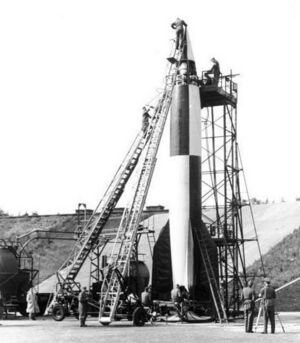
Dulles was in contact with the Austrian resistance group around the priest Heinrich Maier, who collected information through many different contacts with scientists and the military. From 1943 onwards, he received very important information from this resistance group about V-1, V-2 rockets, Tiger tanks, Messerschmitt Bf 109, Messerschmitt Me 163 Komet and other aircraft and the related factories. Allied bombers were thus able to target war-decisive armaments factories. In particular, Dulles then had crucial information for Operation Crossbow and Operation Hydra. The group reported to him about the mass murder in Auschwitz. Through the Maier Group and Kurt Grimm, Dulles also received information about the economic situation in the Nazi sphere of influence. After the resistance group was uncovered by the Gestapo, Dulles sent American agents to Austria to contact any surviving members.[21][22][23][24][25]
Although Washington barred Dulles from making firm commitments to the plotters of the 20 July 1944 attempt to assassinate Hitler, the conspirators nonetheless gave him reports on developments in Germany, including sketchy but accurate warnings of plans for Hitler's V-1 and V-2 missiles.[26]
Dulles was involved in Operation Sunrise, secret negotiations in March 1945 to arrange a local surrender of German forces in northern Italy. His actions in Operation Sunrise have been criticized by historians for offering German SS General Karl Wolff protection from prosecution at the Nuremberg trial, and creating a diplomatic rift between the U.S. and U.S.S.R. After the war in Europe, Dulles served for six months as the OSS Berlin station chief and later as station chief in Bern.[27] The Office of Strategic Services was dissolved in October 1945 and its functions transferred to the State and War Departments.
In 1947, Dulles served as a senior staffer on the Herter Committee.[28]
In the 1948 Presidential election, Dulles was, together with his brother, an advisor to Republican nominee Thomas E. Dewey. The Dulles brothers and James Forrestal helped form the Office of Policy Coordination. During 1949 he co-authored the Dulles–Jackson–Correa Report, which was sharply critical of the Central Intelligence Agency, which had been established by the National Security Act of 1947. Partly as a result of the report, Truman named a new Director of Central Intelligence, Lieutenant General Walter Bedell Smith.
عمله في المخابرات المركزية
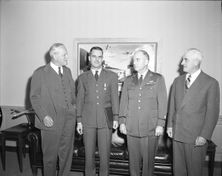
تم توظيف ألن دلس في المخابرات المركزية للإشراف على العمليات السرية للوكالة كنائب مدير للخطط، المنصب الذي تقلده من 4 يناير 1951. في 23 أغسطس 1951، ترقى دلس لمنصب نائر مدير المخابرات المركزية، الثاني في قيادة الوكالة. من خلال منصبه هذا، كان دلس، في 1952-53، واحداً من خمس أعضاء في فريق مستشاري وزارة الخارجية حول نزع السلاح خلال السنوات الأخيرة من إدارة ترومان.[29]
بعد انتخاب دوايت أيزنهاور عام 1952، نُقل بدل سميث إلى وزارة الخارجية وأصبح دلس أول مدير مدني للمخابرات المركزية. لعب دلس دوراً في إقناع أيزنهاور ابتباع إحدى استنتاجات تقرير لجنة وزارة الخارجية، أن الشعب الأمريكي يستحق أن يتم إعلامه بمخاطر الحرب النووية المحتملة مع الاتحاد السوڤيتي، لأنه على الرغم من أن أمريكا كانت لديها التفوق النووي العددي، إلا أن السوڤييت لا يزال لديهم أسلحة نووية كافية بإلحاق ضرر جسيم بالمجتمع الأمريكي بغض النظر عن عدد هذه القنابل التي قد تمتلكها الولايات المتحدة أو مدى خطورة تلك الأسلحة الأمريكية في تدمير السوڤييت.[29]
كانت العمليات السرية التي تعقدها الوكالة جزءاً هاماً من سياسة الأمن القومي الجديدة التي اتبعتها إدارة أيزنهاور أثناء الحرب الباردة، والمعروفة "بالنظرة الجديدة.
بطلب من دلس، طلب الرئيس أيزنهاور من السناتور جوسف مكارثي بالتوقف عن إصدار مذكرات استدعاء ضد المخابرات المركزية. في مارس 1950، كان مكرثي قد بدأ سلسلة من التحقيقات حول التخريب المحتمل للوكالة الشيوعية. على الرغم من عدم كشف التحقيقات عن أي مخالفات، إلا أن جلسات الاستماع قد تكون مضرة، ليس فقط بسمعة وكالة المخابرات المركزية ولكن أيضاً بأمن المعلومات الحساسة. كشفت الوثائق التي تم نشرها عام 2004 أن وكالة المخابرات المركزية، بأوامر من دلس، اقتحم مكتب مكارثي في مجلس الشيوخ وقُدمت له معلومات مضللة من أجل تشويه سمعته، من أجل إيقاف تحقيقه في اختراق الشيوعيين لوكالة المخابرات المركزية.[30]
في أوائل الخمسينيات، عقدت القوات الجوية الأمريكية منافسة لاختيار طائرة استطلاع جديدة. قدمت سكونك ووركس التابعة لشركة لوكهيد للطائرات رقم التصميم CL-282، التي تححتوي على أجنحة تشبه الطائرة الشراعية بجسم اعتراضي أسرع من الصوت. رفضت القوات الجوية هذه الطائرة، لكن العديد من المدنيين ضمن فريق المراجعة دونوا ملاحظات، وقدم إدوين لاند عرضاً للطائرة إلى دلس. أصبحت الطائرة ما عُرف لاحقاً بطائرة التجسس يو-2، وقد تم تشغيلها في البداية بواسطة طيارين من وكالة المخابرات المركزية. أدى إدخالها في الخدمة العملياتية عام 1957 إلى تعزيز قدرة وكالة المخابرات المركزية بشكل كبير على مراقبة نشاط السوڤييت من خلال مراقبة الصور العلوية. وفي النهاية دخلت الطائرة الخدمة مع القوات الجوية.[31] قام الاتحاد السوڤيتي بإسقاط والاستيلاء على إحدى طائرات يو-2 عام 1960 عندما كان دلس رئيساً للمخابرات المركزية.[2]
يعتبر دلس واحداً من المؤسسين الأساسيين لنظام المخابرات الأمريكي الحديث وكان دليلاً لا غنى عنه للعمليات السرية خلال الحرب الباردة. أنشأ شبكات استخبارات في جميع أنحاء العالم لفحص ومواجهة التقدم الشيوعي السوپيتي وفي أوروپا الشرقية وكذلك الحركات الشيوعية الدولية.[32][19][33][صفحة مطلوبة]
الانقلاب في إيران
عام 1952، شارك دلس مع فرنك ويسنر،[34][صفحة مطلوبة] في العملية أجاكس، عملية سرية أدت إلى الإطاحة برئيس الوزراء الإيران المُنتخب-ديمقراطياً محمد مصدق،[35] واستبداله بشاه إيران محمد رضا پهلوي. ظهرت شائعات عن استيلاء السوڤيتيت على البلاد بسبب تأميم شركة النفط الأنگلو-فارسية. اقترح الدبلوماسي البريطاني كريستوفر وودهاوس على الرئيس أيزنهاور فكرة الانقلاب لمحاولة استعادة السيطرة البريطانية على شركة النفط.[بحاجة لمصدر]
الانقلاب في گواتيمالا
عام 1954 تم الإطاحة بالرئيس الگواتيمالي جاكوبو أربنز گوكمان في انقلاب قادته المخابرات المركزية تحت الاسم الرمزي العملية PBSuccess.[36]
وصف إدواردو گاليانو دلس باعتباره عضو سابق في مجلس ادارة شركة يونايتد فروت.[37] ومع ذلك، في فحص مفصل للروابط بين شركة يونايتد فروت وإدارة أيزنهاور، لم يذكر إمرمان أن دلس كان جزءاً من مجلس إدارة شركة يونايتد فروت، على الرغم من أنه لاحظ أن سليڤان أند كروموِل قد مثلت الشركة.[38]
. . . . . . . . . . . . . . . . . . . . . . . . . . . . . . . . . . . . . . . . . . . . . . . . . . . . . . . . . . . . . . . . . . . . . . . . . . . . . . . . . . . . . . . . . . . . . . . . . . . . . . . . . . . . . . . . . . . . . . . . . . . . . . . . . . . . . . . . . . . . . . . . . . . . . . . . . . . . . . . . . . . . . . . .
خليج الخنازير
العديد من مؤامرات الاغتيال الفاشلة ضد كاسترو، التي استخدمت عملاء جندتهم المخابرات المركزية وكوبيون مناهضون لكاسترو بشكل مباشر، قوضت مصداقية المخابرات المركزية. تدهورت سمعة الوكالة ومديرها بشكل كبير بعد فشل غزو خليج الخنازير. وبحسب ما ورد قال الرئيس كندي إنه يريد "تقسيم وكالة المخابرات المركزية إلى ألف قطعة وذروها في مهب الريح". ومع ذلك، بعد "تحقيق دقيق في شؤون الوكالة وأساليبها ومشاكلها ... لم يقم [كندي]" بتقسيمها "بعد كل شيء ولم يوصِ بإشراف الكونگرس".[39]
الطرد
في عهد إدارة كندي، واجه دلس انتقادات متزايدة.[2] في خريف 1961، في أعقاب حادث خليج الخنازير وانقلاب الجنرالات ضد شارل ديجول، أُجبر دالاس ورفاقه، بما في ذلك نائب مدير الخطط رتشارد بيسل ونائب المدير تشارلز كابل، على الاستقالة. في 28 نوفمبر 1961، قدم كندي إلى دالاس وسام الأمن القومي في مقر وكالة المخابرات المركزية في لانگلي، ڤرجينيا.[40] في اليوم التالي، 29 نوفمبر، أصدر البيت الأبيض استقالة وقع عليها دلس لاحقاً.[41]
منشورات
مقالات
- "The Power of the President Over Foreign Affairs". Michigan Law Review, Vol. 14, April 1916. pp. 470–478. JSTOR 1275947 DOI:10.2307/1275947
- “Some Misconceptions About Disarmament”. Foreign Affairs, Vol. 5, No. 3, April 1927. pp. 413–424. JSTOR 20028543 DOI:10.2307/20028543
- “Progress Toward Disarmament”. Foreign Affairs, Vol. 11, No. 1, October 1932. pp. 54–65. JSTOR 20030483 DOI:10.2307/20030483
- “Alternatives for Germany”. Foreign Affairs, Vol. 25, No. 3, April 1947. pp. 421–432. JSTOR 20030052 DOI:10.2307/20030052
- “That Was Then: Allen W. Dulles on the Occupation of Germany”. Foreign Affairs, Vol. 82, No. 6, November/December 2003. pp. 2–8. JSTOR 20033751 DOI:10.2307/20033751
مراجعات كتب
- Review of Communism and Revolution: The Strategic Use of Political Violence by Cyril E. Black & Thomas P. Thornton. Harvard Law Review, Vol. 78, No. 7, May 1965. pp. 1500–1502. JSTOR 1338919 DOI:10.2307/1338919
كتب
- Can We Be Neutral? Co-authored with Hamilton Fish Armstrong. New York: Harper & Brothers, 1936. OCLC 513361
- Can America Stay Neutral? Co-authored with Hamilton Fish Armstrong. New York: Harper & Brothers, 1939. OCLC 256170
- Germany's Underground. New York: The Macmillan Company, 1947. قالب:Lccn
- The Marshall Plan. Co-authored by Michael Wala. Providence, RI: Berg, 1993. ISBN 978-0854963508
- From Hitler's Doorstep: The Wartime Intelligence Reports of Allen Dulles, 1942–1945. Co-authored with Neal H. Peterson. University Park, PA: Pennsylvania State University Press, 1999. ISBN 0271014857
- The Secret Surrender: The Classic Insider's Account of the Secret Plot to Surrender Northern Italy During WWII. Guilford, CT: The Lyons Press, 2004. ISBN 1592283683
- The Craft of Intelligence: America's Legendary Spy Master on the Fundamentals of Intelligence Gathering for a Free World. Guilford, CT: The Lyons Press, 1963. ISBN 1592282970
تحرير كتب
- Great True Spy Stories. New York: Harper & Row, 1968.
اسهامات في كتب
- “Foreword”. To the Bitter End: An Insider’s Account of the Plot to Kill Hitler by Hans B. Gisevius. New York: Da Capo Press, 1998.
انظر أيضاً
المصادر
- ^ خطأ استشهاد: وسم
<ref>غير صحيح؛ لا نص تم توفيره للمراجع المسماةobit - ^ أ ب ت ث "Obituaries 1969", Britannica Book of the Year 1970, Chicago: Encyclopædia Britannica, Inc., 1970, p. 580, ISBN 0-85229-144-2, https://archive.org/details/britannicabookof00noau/page/580
- ^ "Allen Welsh Dulles – CIA director". CNN. Archived from the original on 2008-01-07. Retrieved 2011-09-16.
- ^ McLean, R. (March 31, 1911). Scribner, Charles; Halsey, Frank D.; Jones, Spencer L.; Belknap, C.; Thomas, E.W. (eds.). "Twelve Freshman Debates Chosen From Whig Hall". The Daily Princetonian. Vol. 36, no. 29. Princeton, New Jersey, USA: The Daily Princetonian Publishing Company Princeton University Press. p. 457. ISSN 0885-7601. Retrieved September 27, 2021 – via Princeton University Library.
- ^ "FRITZ MOLDEN DIVORCED; Former Joan Dulles Charges Cruelty -- Will Be Wed Again". The New York Times. February 4, 1954. Retrieved April 4, 2022.
- ^ Grose 1994, pp. 457.
- ^ "When a C.I.A. Director Had Scores of Affairs". The New York Times. November 10, 2012. Retrieved November 5, 2014.
- ^ Richard Breitman et al. (2005). OSS Knowledge of the Holocaust. In: U.S. Intelligence and the Nazis. pp. 11–44. [Online]. Cambridge: Cambridge University Press. Available from: Cambridge Books Online DOI:10.1017/CBO9780511618178.006 [Accessed April 20, 2016]. page 25
- ^ Grose 1994, pp. 65, 80–81.
- ^ أ ب Grose 1994, pp. 26.
- ^ Grose 1994, pp. 36, 46.
- ^ "History of CFR: Appendix: Historical Roster of Directors and Officers". Council on Foreign Relations. Retrieved 2011-09-16.
- ^ Grose 1994, pp. 100, 112.
- ^ Grose 1994, pp. 111-116.
- ^ Mosley 1978, pp. 91–92.
- ^ Grose 1994, pp. 121–122.
- ^ أ ب Srodes 1999, pp. 189–190.
- ^ Dulles & Armstrong 1936a.
- ^ أ ب Grose 1994, p. 121.
- ^ Dulles & Petersen 1996, Notes.
- ^ Hansjakob Stehle "Die Spione aus dem Pfarrhaus (German: The spy from the rectory)" In: Die Zeit, 5 January 1996.
- ^ Fritz Molden "Fires In The Night: The Sacrifices And Significance Of The Austrian Resistance" ((2019).
- ^ Helga Thoma "Mahner-Helfer-Patrioten: Porträts aus dem österreichischen Widerstand" (2004), pp 150.
- ^ Elisabeth Boeckl-Klamper, Thomas Mang, Wolfgang Neugebauer: Gestapo-Leitstelle Wien 1938–1945. Vienna 2018, ISBN 978-3902494832, pp. 299–305.
- ^ Christoph Thurner "The CASSIA Spy Ring in World War II Austria: A History of the OSS's Maier-Messner Group" (2017), pp 187.
- ^ Grose 1994, pp. 214.
- ^ Talbot, David (2015). The Devil's Chessboard: Allen Dulles, the CIA, and the Rise of America's Secret Government. HarperCollins. ISBN 978-0062276216
- ^ United States Council of Economic Advisers (CEA) (1 October 1947). McDonald Jr., John W.. ed. Certain Reports and Proposals on Foreign Aid. Washington, D.C., United States of America: United States Department of State/Executive Office of the President of the United States (EOP). p. 1. Archived from the original. You must specify the date the archive was made using the
|archivedate=parameter. http://www.marshallfoundation.org/library/wp-content/uploads/sites/16/2014/04/Studies_Prior_to_the_Marshall_Plan.pdf. Retrieved on 27 September 2021. - ^ أ ب Bernstein, Barton J. (Fall 1987). "Crossing the Rubicon: A Missed Opportunity to Stop the H-Bomb?". International Security. 14 (2): 141, 155–156.
- ^ Weiner 2007, pp. 105–106.
- ^ Powers, Francis (2004). Operation Overflight: A Memoir of the U-2 Incident. Potomac Books, Inc. p. 324. ISBN 9781574884227.
- ^ Srodes 1999, p. 22.
- ^ Dulles & Armstrong 1939.
- ^ Trento 2001.
- ^ Loretta Capeheart and Dragan Milovanovic, Social Justice: Theories, Issues, and Movements (Rutgers University Press, 2007; ISBN 0813540380), p. 186.
- ^ Immerman 1982, pp. 133-160.
- ^ Galeano, Eduardo (1991). Open Veins of Latin America. NYU Press. p. 113. ISBN 1583673113. Retrieved 26 June 2018.
- ^ Immerman 1982, pp. 124.
- ^ "CIA: Maker of Policy, or Tool?". The New York Times. April 25, 1966. p. 20, column 3. Retrieved 2011-09-16.
- ^ John F. Kennedy. Remarks Upon Presenting an Award to Allen W. Dulles, November 28, 1961 (Gerhard Peters and John T. Woolley, The American Presidency Project).
- ^ "Dulles, Allen W., June 1959-November 1962". Jfklibrary.org. Retrieved 5 November 2014.
المراجع
- Dulles, Allen; Armstrong, Hamilton Fish (1936). Can We Be Neutral?. New York: Harper & Brothers. OCLC 513361.
{{cite book}}: Invalid|ref=harv(help) - Dulles, Allen; Armstrong, Hamilton Fish (1939). Can America Stay Neutral?. New York: Harper & Brothers. OCLC 256170.
{{cite book}}: Invalid|ref=harv(help) - Dulles, Allen (1947). Germany's Underground. New York: The Macmillan Company. p. 207. LCCN 47002566.
- Dulles, Allen; Wala, Michael (1993). The Marshall Plan. Providence, RI: Berg. ISBN 978-0-85496-350-8.
{{cite book}}: Invalid|ref=harv(help) - Dulles, Allen; Petersen, Neal H. (1999). From Hitler's Doorstep: The Wartime Intelligence Reports of Allen Dulles, 1942–1945. University Park, PA: Pennsylvania State University Press. ISBN 0-271-01485-7.
{{cite book}}: Invalid|ref=harv(help) - Dulles, Allen (2000). Germany's Underground; with a new introduction by Peter Hoffmann. New York: Da Capo Press. ISBN 0-306-80928-1.
{{cite book}}: Invalid|ref=harv(help) - Dulles, Allen (2004). The Secret Surrender: The Classic Insider's Account of the Secret Plot to Surrender Northern Italy During WWII. Guilford, CT: The Lyons Press. ISBN 1-59228-368-3.
{{cite book}}: Invalid|ref=harv(help) - Dulles, Allen (1963). The Craft of Intelligence: America's Legendary Spy Master on the Fundamentals of Intelligence Gathering for a Free World (PDF). Guilford, CT: The Lyons Press. ISBN 1-59228-297-0.
{{cite book}}: Invalid|ref=harv(help) - Grose, Peter. Gentleman Spy: The Life of Allen Dulles. Boston, MA: Houghton Mifflin, 1994. ISBN 978-0395516072
- Immerman, Richard H. (1982). The CIA in Guatemala: The Foreign Policy of Intervention. University of Texas Press. ISBN 978-0-292-71083-2.
{{cite book}}: Invalid|ref=harv(help) - Kinzer, Stephen. The Brothers: John Foster Dulles, Allen Dulles, and Their Secret World War. New York: Times Books, 2013. ISBN 978-0805094978
- Lisagor, Nancy; Lipsius, Frank (1988). A Law Unto Itself: The Untold Story of the Law Firm Sullivan and Cromwell. New York: William Morrow. ISBN 0-688-04888-9.
{{cite book}}: Invalid|ref=harv(help) - Loftus, John; Aarons, Mark (1994). The Secret war against the Jews: How Western Espionage Betrayed the Jewish People. New York: St. Martin's Griffin. ISBN 978-0-312-15648-0.
{{cite book}}: Invalid|ref=harv(help) - Mosley, Leonard (1978). Dulles: A Biography of Eleanor, Allen, and John Foster Dulles and their Family Network. New York: Dial Press.
{{cite book}}: Invalid|ref=harv(help) - Srodes, James (1999). Allen Dulles: Master of Spies. Washington, D.C.: Regnery. ISBN 0-89526-314-9.
{{cite book}}: Invalid|ref=harv(help) - Trento, Joseph John (2001). The Secret History of the CIA. Roseville, CA: Prima. ISBN 978-0-7615-2562-2.
{{cite book}}: Invalid|ref=harv(help) - Weiner, Tim (2007). Legacy of Ashes: The History of the Central Intelligence Agency. New York: Doubleday. ISBN 978-0-385-51445-3.
{{cite book}}: Invalid|ref=harv(help)
. . . . . . . . . . . . . . . . . . . . . . . . . . . . . . . . . . . . . . . . . . . . . . . . . . . . . . . . . . . . . . . . . . . . . . . . . . . . . . . . . . . . . . . . . . . . . . . . . . . . . . . . . . . . . . . . . . . . . . . . . . . . . . . . . . . . . . . . . . . . . . . . . . . . . . . . . . . . . . . . . . . . . . . .
قراءات إضافية
- Hastings, Max (2015). The Secret War: Spies, Codes and Guerrillas, 1939-1945. London: William Collins. ISBN 978-0007503742
- Peyrefitte, Alain (2011). C'etait de Gaulle. Distribooks. ISBN 978-2253151852
- Sharp, Tony (2014). Stalin's American Spy: Noel Field, Allen Dulles and the East European Show-Trials. Hurst. ISBN 978-1849044967
- Talbot, David (2015). The Devil's Chessboard: Allen Dulles, the CIA, and the Rise of America's Secret Government. HarperCollins. ISBN 978-0062276216
- von Lingen, Kerstin (2013). Allen Dulles, the OSS, and Nazi War Criminals: The Dynamics of Selective Prosecution. Cambridge University Press. ISBN 978-1107025936
وصلات خارجية
أعمال متوافرة أونلاين
- Works by Allen Dulles at Internet Archive
- Works by Allen Dulles at Foreign Affairs
- Works by Allen Dulles at JSTOR
- Works by Allen Dulles at Online Books Page
مواد أرشيفية
- References to Allen Dulles at Central Intelligence Agency
- Personal papers at the Seeley G. Mudd Manuscript Library at Princeton University
- FBI file on Allen Dulles
- “The Role of Intelligence in Policy Making” (RAM). Audio recording of a lecture given by Dulles.
| مناصب حكومية | ||
|---|---|---|
| منصب حديث | نائب مدير المخابرات المركزية للخطط 1951 |
تبعه فرانك وايزنر |
| سبقه وليام جاكسون |
نائب مدير المخابرات المركزية 1951–1953 |
تبعه تشارلز كابل |
| سبقه والتر سميث |
مدير المخابرات المركزية 1953–1961 |
تبعه جون مكون |
- الولايات المتحدة
- الاتحاد السوڤيتي
- الحرب الباردة
- محمد رضا پهلوي
- أمريكا
- البيت الأبيض
- دوايت أيزنهاور
- وكالة المخابرات المركزية
- محمد مصدق
- مجلس الشيوخ
- إدوين لاند
- القوات الجوية الأمريكية
- جون فوستر دلس
- غزو خليج الخنازير
- لوكهيد
- الانقلاب الإيراني 1953
- طائرة استطلاع
- شركة النفط الأنگلو-فارسية
- جوسف مكارثي
- ألن دلس
- CS1: Julian–Gregorian uncertainty
- Short description is different from Wikidata
- مقالات بالمعرفة بحاجة لذكر رقم الصفحة بالمصدر from September 2011
- Articles with unsourced statements from September 2017
- مواليد 1893
- وفيات 1969
- مناهضو الشيوعية الأمريكان
- جواسيس أمريكان
- جواسيس أمريكان في الحرب العالمية الثانية
- مدفونون في مقبرة گرين ماونت
- نواب مديرو وكالة المخابرات المركزية
- مديرو وكالة المخابرات المركزية
- عائلة دلس
- خريجو كلية الحقوق، جامعة جورج واشنطن
- الثورة الگواتيمالية
- أعضاء لجنة وارن
- محامو ولاية نيويورك
- جمهوريو ولاية نيويورك
- أشخاص من أزمة الكونغو
- أشخاص من مكتب الخدمات الاستراتيجية
- خريجو جامعة پرنستون
- Project MKUltra
- مركز روكفلر
- خريجو أكاديمية فليپس إكستر
- وفيات بالإنفلونزا
- شركاء سوليڤان أند كروموِل
- World War II spies for the United States

